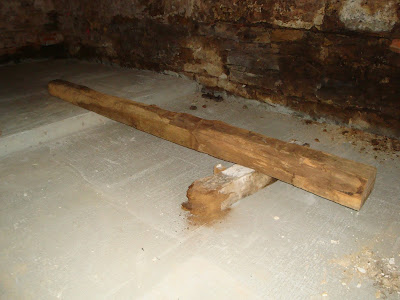Or, up me beam, to be more accurate.
A few weeks ago, my wife arranged to get an old oak beam from a chap in the next village. Lutz (our carpenter) and I duly went over to pick it up, and man-handled 5 metres of solid oak onto his truck and then left it outside our barn. It was supposed to be installed in the living room to replace the cracked beam. Unfortunately, as Lutz was heading off on holiday, it didn't happen in time. So, Jörg and I took matters into our own hands and a few weeks ago, with the help of a chainsaw, we took the old beam out.
 |
| The old, cracked one, still in place (middle one) |
The replacement beam was moved from outside to one of the cellars where it got a cleanup with a sandblaster and other, finer implements last week. To be honest, the beam had been worrying me, as not only was it to support the floor above, but it does have some structural role to play, as it anchors into the west gable wall. Yesterday, despite having little desire to do any work, I began preparing the sockets (well, holes in the wall) in preparation for the beam. I had no intention of going any further till Jörg arrived unannounced, which led to us asking another neighbour (who happens to be a tradesman) for a loan of a bit of scaffolding and a hand, and who brought two of his helpers with him. Within 30 or 40 minutes of them arriving we had carried the beam up to the first floor and installed it. My precision measurements were mocked, and rightly so. An experienced tradesman took over, hacked a bit with a masonry chisel, and we were done.
The professionals departing as swiftly as they arrived, Jörg and I were left to connect the beam to the iron anchor in the gable (that took longer to do due to breaking bolts!) and attempt to tie it into the beams on the other side of the room. I need a longer drill bit to finish that part, but the main thing is we have a new beam in, and I won't wake up in a sweat worrying about it any more.
 |
| The beam, pre-cleanup. |
 |
| And fitted! |
 |
| Anchor in the west gable, ready to be connected |
 |
| Final span is 4 metres |
 |
| Jörg adding some final touches. |
The sockets have to be refilled and the beam wedged in, so the support struts will stay in place till that's done.
In other news: my usual camera broke, for the third time, so it's time for a new one. I had replaced the lens myself twice, after it had been dropped, but I think this time it's from dust. I don't like the colours of the photos my old backup camera takes (see above!).









